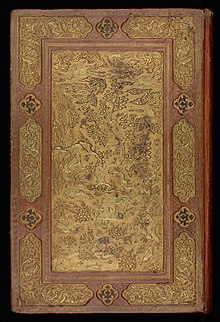
Back كتاب أكبر Arabic আকবৰনামা Assamese আকবরনামা Bengali/Bangla Akbarnama Catalan Akbar-nāma German Akbarnama Spanish اکبرنامه Persian अकबरनामा Hindi Akbarnama Italian ಅಕ್ಬರನಾಮ Kannada
 Binding from "Akbarnama", c. 1600 – 1605 at the Chester Beatty Library. | |
| Author | Abul Fazl and Faizi Sirhindi |
|---|---|
| Language | Persian |
| Genre | Biography |
| Set in | 16–17th century Mughal India |
Publication date | 1600–1605 |
| Publication place | Mughal Empire (India) |
The Akbarnama (Persian: اکبرنامه; lit. 'The Book of Akbar'), is the official chronicle of the reign of Akbar, the third Mughal Emperor (r. 1556–1605), commissioned by Akbar himself and written by his court historian and biographer, Abul Fazl. It was written in Persian, which was the literary language of the Mughals, and includes vivid and detailed descriptions of his life and times.[1] It followed the Baburnama, the more personal memoir by his grandfather, Babur, founder of the dynasty. It was produced in the form of lavishly illustrated manuscripts.
The work was commissioned by Akbar, and written by Abul Fazl, who was one of the Nine Jewels (Hindustani: Navaratnas) of Akbar's royal court. It is stated that the book took seven years to be completed. The original manuscripts contained many miniature paintings supporting the texts, thought to have been illustrated between c. 1592 and 1594 by at least forty-nine different artists from Akbar's imperial workshop,[2] representing the best of the Mughal school of painting, and masters of the imperial workshop, including Basawan, whose use of portraiture in its illustrations was an innovation in Indian art.[3]
After Akbar's death in 1605, the manuscript remained in the library of his son, Jahangir (r. 1605–1627) and later Shah Jahan (r. 1628–1658). Today, the Victoria and Albert Akbarnama, with 116 miniature paintings, is at the Victoria and Albert Museum. It was bought by the South Kensington Museum (now the V&A) in 1896 from Mrs Frances Clarke, acquired by her husband upon his retirement from serving as Commissioner of Oudh (1858–1862). Soon after, the paintings and illuminated frontispiece were removed from the volume to be mounted and framed for display.[4]
- ^ Illustration from the Akbarnama: History of Akbar Archived 2009-09-19 at the Wayback Machine Art Institute of Chicago
- ^ "Akbar's mother travels by boat to Agra". V & A Museum.
- ^ Illustration from the Akbarnama: History of Akbar Archived 2009-09-19 at the Wayback Machine Art Institute of Chicago
- ^ "Conservation and Mounting of Leaves from the Akbarnama". Conservation Journal (24). July 1997. Archived from the original on 2008-03-24.